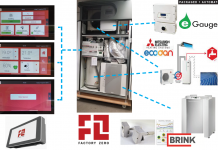Tom Konrad CFA
FLIR Systems‘ (FLIR) IR cameras save energy not just by spotting leaks, but by spotting intruders in the dark.
When I published my list of dividend paying energy efficiency stocks in January, I missed one, and it is a long-time favorite. FLIR Systems (FLIR) business is focused around thermography, and I picked FLIR as a stock likely to benefit from the stimulus in March 2009 because FLIR’s cameras are used by energy raters.

FLIR did benefit from the stimulus, rising 56% by the end of 2009 from the $21 price when I made my call, but the stock has been basically flat since then, despite continued earnings and cash flow growth, and the declaration of a $0.06 (0.8% annual) dividend which was first paid in February, just two weeks too late to be included in my dividend paying energy efficiency stocks list. The dividend corresponds to a 13% payout ratio, meaning that 87% of the company’s earnings will be retained for continued acquisitions, stock buybacks, and investing in the business.

Thermography
I first became interested in FLIR in 2007, when I expected the use of thermography to grow rapidly in the likewise growing business of energy rating. Given that stimulus funding for energy rating will be running out this year, it seems likely that growth from this end of the business will slow, at least in the near term. Over the longer term, I expect the energy efficiency side of the business to remain robust because falling prices and better resolution will rapidly open new markets, and thermography remains one of the most effective ways to help the non-professional understand the importance of heat loss.  It’s one thing to tell a homeowner that their insulation is poorly installed. It’s quite another to show them in an image like the one to the right.
It’s one thing to tell a homeowner that their insulation is poorly installed. It’s quite another to show them in an image like the one to the right.
Nor is thermographic imaging solely a tool for convincing homeowners that there is a problem. By simplifying the detection and diagnosis of not only problems with insulation, but a long list of residential, commercial, and industrial systems, much time, money, and often energy is saved in fixing those problems.
One unique application of thermography is FLIR’s Gas imaging cameras. These can help detect leaks of powerful greenhouse gasses such as Sulfur Hexaflouride (used in electric transformers) natural gas, and several other dangerous and expensive industrial chemicals.
Competition
FLIR’s major competitor in thermal cameras is Fluke, a division of Danaher (DHR). I talked to representatives of both Fluke and FLIR at Building Energy 11 in Boston on March 9th and 10th. (I went to conduct a workshop on clean energy investing.) I asked both of them the same question: If I were an energy rater, why should I buy Fluke’s camera over FLIR’s, or vice versa? The Fluke rep’s line was that Fluke “builds tools” and that I could expect a Fluke camera to be more rugged and not break, and this is something I should be willing to pay a little more for. The FLIR rep said simply that their camera offers better resolution at a lower price point, and comes with a 2 year warranty.
I found FLIR’s sales pitch far more convincing than Fluke’s. That’s one of two reasons this article is about FLIR, not both FLIR and Fluke. The other reason is that thermography is such a tiny part of Danaher’s business that it’s not material from an investing perspective.
Commercial Vision Systems
I used to think that the main reason for energy efficiency investors to be interested in FLIR was the company’s Thermography division (26% of 2010 revenues,) but discovered another application while talking to the FLIR representative. The company’s Commercial Vision Systems division (21% of 2010 revenues) is promoting their security cameras for cost-effective intruder detection . Because the cameras use thermal imaging, they don’t require lighting to spot the body heat of intruders at night, which is where the energy savings come in. The ability to eliminate security lighting allows FLIR’s security cameras to be installed at comparable costs with conventional systems, while saving the electricity which would otherwise be used to light unoccupied areas, as well as reducing light pollution.
. Because the cameras use thermal imaging, they don’t require lighting to spot the body heat of intruders at night, which is where the energy savings come in. The ability to eliminate security lighting allows FLIR’s security cameras to be installed at comparable costs with conventional systems, while saving the electricity which would otherwise be used to light unoccupied areas, as well as reducing light pollution.
The commercial division also supplies cameras for traffic monitoring, a service which fits well into my “Smart Transportation” peak oil investment theme.
Government Systems
Despite the many energy saving applications of FLIR’s products, socially responsible investors may have a problem with investing in the company because slightly over half of FLIR’s revenue comes from their government systems division, which provides vision systems for military and homeland security applications. It’s unlikely that FLIR’s products are going to kill anyone, but they help aim, and it should be acknowledged that military customers are a significant source of revenue.
Moral objections aside, FLIR’s military business is healthy and growing much faster than Defense budgets in general. I’m certainly not a defense expert when it comes to stock analysis, but it seems to me that as defense budgets are slimmed, the trend to use more and more sensor and reconnaissance technology should continue, in order to better target the firepower which is still in the budget. So while this part of FLIR’s business may not be environmentally green, it should continue to add green to the bottom line.
Conclusion
The consensus for FLIR’s expected growth over the next five years has fallen to 15% per annum, compared to 25% annual growth over the last five years. That’s still a respectable growth rate, but makes the trailing P/E of
21 and the forward P/E of 16 seem a little high at the current stock price of $32. I’d like to see the price in the high 20’s before I’d be completely comfortable buying the stock, but that would not require much of a pullback. At the right price, FLIR will be a valuable addition to a green (if not socially responsible) portfolio.
DISCLOSURE: No Position.
DISCLAIMER: The information and trades provided here are for informational purposes only and are not a solicitation to buy or sell any of these securities. Investing involves substantial risk and you should evaluate your own risk levels before you make any investment. Past results are not an indication of future performance. Please take the time to read the full disclaimer here.








